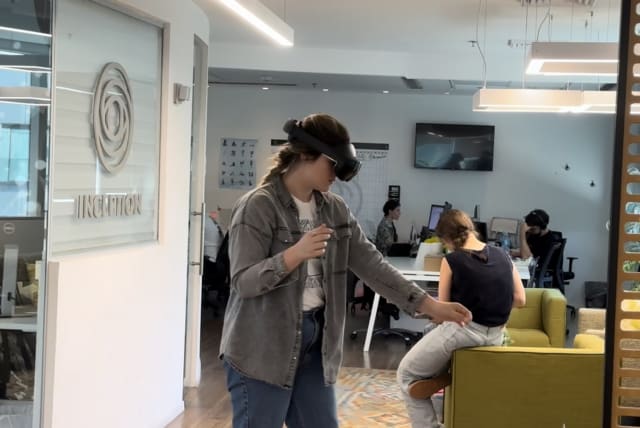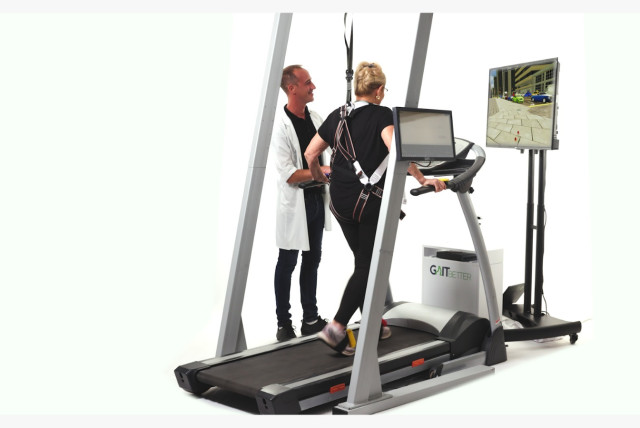Israeli VR firms aim to fill in gaps in US healthcare challenges

Israeli start-ups are developing virtual reality simulations that aim to ease the burden in struggling sectors of the US healthcare system, such as nursing and preventive care.
As the world struggles with a shortage of registered nurses in the wake of the COVID-19 pandemic, several Israeli start-ups have been developing new virtual reality products aimed at assisting both nurses and patients, especially in the US market.
According to the World Health Organization, before the pandemic began in 2020, there was already a global shortage of nearly 6 million nurses. The pandemic exacerbated the situation, and the world shortage is expected to reach 13 million by 2030 unless drastic action is taken.
In the United States, it is estimated that over 1 million new nurses will be needed by 2030.
“We are in one of the worst staffing crises that we’ve been in,” Assistant Dean for Academics with the Vanderbilt School of Nursing Mary A. Jessee told The Media Line. “All of the challenges that the global pandemic brought really wreaked havoc on the emotional and mental health of a lot of nurses, causing many to leave the profession.”
Which Israeli start-ups are helping the US healthcare systems with VR?
One Israeli start-up has developed a product aimed at helping to train nurses in the US more quickly and efficiently.
InceptionXR, a VR company founded in 2016 and based in Tel Aviv, used to develop educational simulations for children. However, it is now focusing on one issue that nurses in hospitals face daily: preventing hospital-associated infections. The US Centers for Disease Control estimates that 1.7 million people are infected and around 100,000 people die from infections contracted inside a hospital each year in the US. Although nurses are trained in how to avoid spreading such infections, this can be difficult to perfect.
“COVID made it very clear how important it is to avoid infection,” InceptionXR's Vice President of Sales and Business Development Ariel Geva told The Media Line. “Our aim and our partners’ [aim] is to reduce the number of infections while training the nurses how to act in a room with a patient.”
During training, nurses are taught to avoid spreading pathogens through various techniques, including regular hand washing and wearing masks, gowns, and gloves.
“We approach patient care as if any blood or body fluid is potentially contaminated,” Jessee said. “That is a critical foundation of nursing practice. Understanding and having the ability to apply what we call the principles of infection control is one of the first things that a nursing student learns. That practical training is an essential part of nursing education because nursing is a practice. We have to understand that our students not only know what to do but that they can demonstrate competency in those skills.”
When Vanderbilt trains its students, it uses substances that simulate pathogens and can be traced with black lights, showing students any spots they might have missed and accidentally contaminated.
But setting up such training can be time-consuming.
InceptionXR, in collaboration with Emory University, has been developing a VR simulation that trains nurses to avoid such infections. In the VR training, nurses wear a headset that places them in a virtual hospital room, where they carry out nursing tasks such as inserting an IV into a patient. As the nurse completes the tasks, the simulation tracks the surfaces touched and whether the nurse remembered to disinfect them. At the end of the simulation, the nurse is presented with a score and shown which areas still have contaminants.
“Nurses work very hard, [but] they have very limited time to do any activities, and they probably make many mistakes during this time. Bringing them into a simulation that makes them think about infection … will just make them think about it when they go to the room to treat patients,” Geva said.
InceptionXR believes that VR training is quicker and easier to set up than actual training rooms, and thus can train many more nurses in a shorter timeframe.
“What we’re doing is taking VR to scale because there are millions of nurses. Our focus is on using VR to transform behaviors of a very broad, dispersed workforce,” InceptionXR co-founder Andrew Mendoza told The Media Line.
Another VR start-up in Tel Aviv has its sights set on a different aspect of the US healthcare system. GaitBetter was established in 2017 with a grant from the Israel Innovation Authority’s Incubators Program, which offers funding to help develop commercial products. Its focus is on preventive care, specifically preventing falls in older people.
GaitBetter's VR involves a large screen attached to a treadmill. The patient, attached to a harness on the treadmill, virtually walks through different scenes on the screen, from city streets to thick forests, sometimes having to step over obstacles or change direction. The movements of the patient's feet are monitored and displayed.
The company boasts that the system can reduce falls by 50% in older adults.
“By adding cognitive aspects to gait exercise, they can significantly improve outcomes and significantly reduce risks of falls,” GaitBetter CEO Hilik Harari told The Media Line.
VR is being welcomed as a useful tool by medical faculty in the US.
“There is so much value in artificial intelligence and virtual types of simulation activities for nursing students and all other health profession students,” Jessee said. “We know that multiple opportunities to practice over time create expertise, and having the appropriate feedback to understand when you’re doing something correctly and when you need to modify is essential to that development of expertise.”
However, both Israeli companies said it is still difficult to break into the US healthcare market.
“The health care system in the US is crazy complicated and very difficult in many aspects,” Harari said. “Unfortunately, the US health care system is not set up or suitable for preventative care.”
And InceptionXR said the sheer size of the US presents a problem too.
“In Israel, everybody knows everyone. It’s very easy to reach people. … I can cover the country in less than a day,” Geva said. “Just the sheer distance between hospitals [in the US] is very hard.”
Despite this, both Israeli companies view the US as a premier destination for their products.
“We naturally try to aim for the US market, because the Israeli market is just too small for a business to raise money or to be attractive enough,” Geva said.
And Harari said: “It was almost natural for us to start in the US when we broke out of Israel. But we are exploring other countries where the health care system promotes preventative care more than the US.”
Some large US companies are also playing a role in promoting novel VR technology. Meta, formerly known as Facebook, is investing heavily in VR start-ups in the US and around the world. And in June, Apple entered the VR market with its announcement of the Apple Vision Pro.
“The Apple headset’s going to be a game changer,” Mendoza said. “I think it’s very exciting that big players like Apple are behind it, as well as obviously people at Facebook where Zuckerberg has made a massive commitment to this medium.”
“When Apple releases a new product into the market, at the end of the day it usually changes the market,” Geva said.
“The idea that large companies promote that technology domain, it fuels the ecosystem with developers, with technology, with cameras, with virtual reality technology,” Harari said. “And then companies and innovators like us can leverage that in order to bring specific solutions for specific pain points.”
For educators, the expanding world of virtual reality presents exciting new opportunities to train the next generation of nursing students.
“In order to make nursing programs accessible for students, we need to have opportunities like this where they can do some of their training at home on their own time,” Jessee said. “[VR] really opens up the possibility for individuals to learn and become nurses in a manner that best fits their life schedule.”
At the same time, the uncertainty of where these technologies might end up leads to some caution for those in academia.
“Using technology just for the sake of technology is not always effective,” Jessee said. “We are really careful to evaluate the utility of a particular project or product and how it can benefit more than it harms the cognitive load and the ability to practice for those students. … [But] when you have the right technology and the right feedback and the right amount of practice then you can really achieve great things using technology.”
Patrick Doyle is a recent graduate of San Diego State University and an intern in The Media Line’s Press and Policy Student Program.
Jerusalem Post Store
`; document.getElementById("linkPremium").innerHTML = cont; var divWithLink = document.getElementById("premium-link"); if (divWithLink !== null && divWithLink !== 'undefined') { divWithLink.style.border = "solid 1px #cb0f3e"; divWithLink.style.textAlign = "center"; divWithLink.style.marginBottom = "15px"; divWithLink.style.marginTop = "15px"; divWithLink.style.width = "100%"; divWithLink.style.backgroundColor = "#122952"; divWithLink.style.color = "#ffffff"; divWithLink.style.lineHeight = "1.5"; } } (function (v, i) { });


